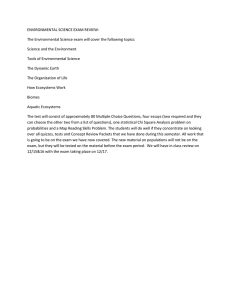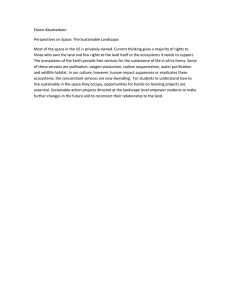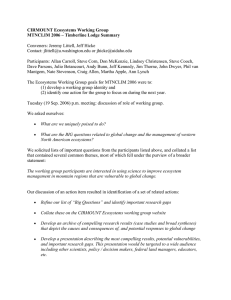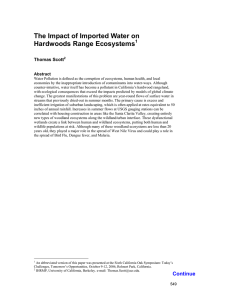SEEA Experimental accounts for ecosystems Issue: Statistical units
advertisement
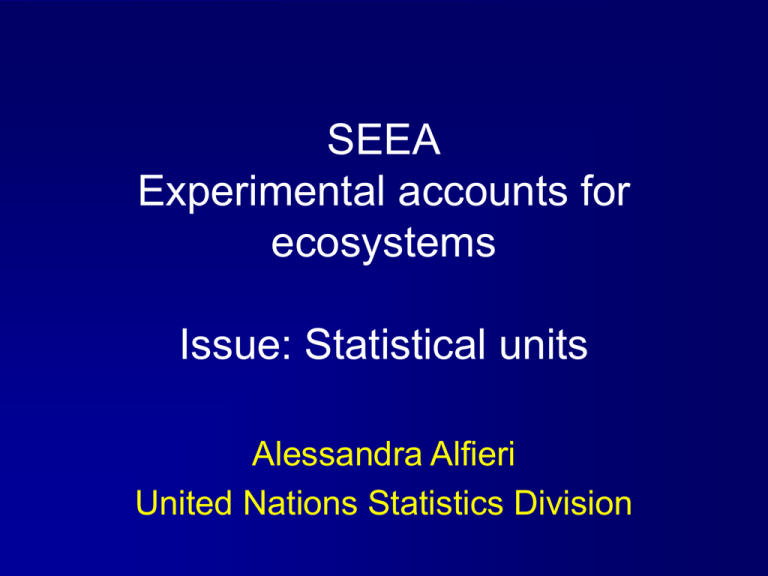
SEEA Experimental accounts for ecosystems Issue: Statistical units Alessandra Alfieri United Nations Statistics Division Outline • The SEEA – Central framework – Experimental accounts for ecosystems • Issue of statistical units – What are statistical units? – Why are they important? – What are they in the economy? – What are they for ecosystems? The SEEA-2003 • The SEEA-2003 is a multipurpose system to organize information. It uses a system approach of stocks and flows • The SEEA-2003 has been perceived as measuring: – The interactions between the economy and the environment • e.g the flow accounts ……but the SEEA-2003 does more. It also measures – The interactions within the environment/ecosystems (natural processes) • e.g. changes in stocks due to human activity and natural causes – The ecosystems in their capacity to provide services to humanity • e.g. asset accounts – land use/land cover accounts, water,carbon, soil resources + other indices The SEEA central framework Data Producers SNA Flows within ecnoomy Economy B Environment agencies and others Material inputs Environment Satellite SEEA SEEA-2003 A Returns e.g. Finance Ministry Changes in stocks NSOs, Environment agencies/scientists Data users A and B are establishments/enterprises and households The SEEA for ecosystems Data Producers NSOs, Environment agencies and others Services provided SEEA Impacts e.g. Finance Ministry Data users X and Yare land cover units Environment X Natural processes SNA Flows within economy Economy Y Environment agencies/scientists Statistical units • Statistical unit • A statistical unit is an entity about which information is sought and for which statistics are ultimately compiled. • It is the unit that provides the basis for statistical aggregates and to which tabulated data refer • Can be defined according to many criteria Statistical units in the economy • Institutional units is capable in its own right to own assets, incur liabilities and engage in economic activities and transactions with other economic units • Establishment Criteria: Production process, location • Enterprise Criterion: autonomy in decision making • Institutional sectors (e.g. corporations, government, households, non profit institutions) Criteria: objectives, functions, behaviour Statistical units for ecosystems • Land provides the space that supports economic activities and ecosystem processes • Need to identify criteria to identify the statistical units for ecosystems Statistical units for ecosystems – Cont’ed STEP 1 • LCCS3 provides information on the objects (e.g. trees, scrubs, etc. on the land) • LCCS3 objects are scale independent • Objects cannot be mapped – too many combinations Land cover types STEP 2 – • Land cover types represent an aggregation of the objects according to specific land cover types (e.g. herbacious crop, tree covered area, etc.) • Land cover types are scale independent • Land cover types cannot be mapped Land Cover Functional Units (LCFU) • STEP 4 • LCFUs arrange biophysical objects in mappable classes according to established patterns • Functionally forms typical cluster of spatial relationships of objects, characteristics and properties of the land • Dominant land cover type LCFU similar to establishment Socio-Ecological Landscape Units (SELU) STEP 4 • Combine LCFU on the basis of topographic characteristic of the land: – – – – River basins Slope and altitude (mountain, highland and lowland) Location (proximity to the sea) Rivers =>SELU similar to enterprise Smallest autonomous unit within which most of the ecosystem process take place Questions • Do the SELUs represent the ecosystems in its diversity, functions, processes and services through ecosystems accounting units in terms of its behaviour in its own rights owning assets and engaging in production? • Are we able to align the concepts of units, production with the SNA? • Are we able to introduce statistical units for oceans and atmosphere?
